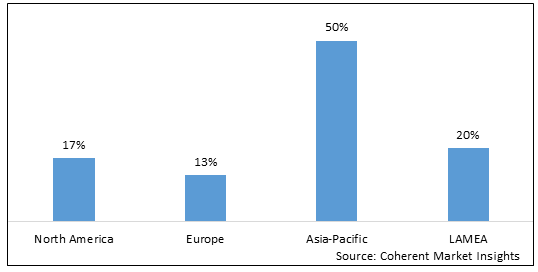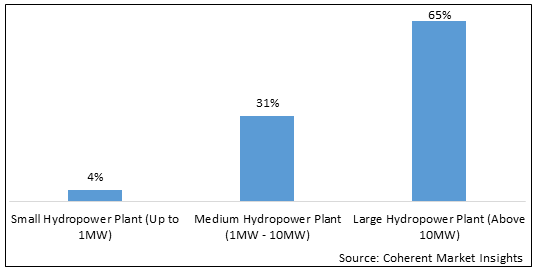Hydropower Generation Market is estimated to be valued at USD 282.6 Bn in 2025 and is expected to reach USD 422.13 Bn in 2032, exhibiting a compound annual growth rate (CAGR) of 5.9% from 2025 to 2032. The global hydropower generation market is expected to witness significant growth due to surge in demand for electricity across the globe. In addition, increasing concern regarding greenhouse gases has boosted the demand for renewable energy sources such as hydropower. The power generated from this source is clean and environment-friendly as it produces few emissions and has a long life span. Moreover, the rising investments in large hydropower plants and pumped storage projects has driven the growth of the market. However, high operational and capital expenditures are the key restraining factor expected to hamper the market growth.
Global Hydropower Generation Market: Regional Insights
Based on geography, the global hydropower generation market is segmented into North America, Europe, Asia Pacific, Latin America, and Middle East & Africa.
In terms of region, Europe is expected to dominate the global hydropower generation market over the forecast period owing to the stringent government regulations that are followed in the process of approvals for hydropower projects. Besides this, the rapid industrialization and urbanization in the region is further driving the market growth.
Asia Pacific is exhibiting an incline for the market growth primarily due to the increasing demand for renewable energy technologies. Moreover, the low electricity prices in the region are fueling the market. North America is expected to be the third largest market for hydropower generation because of growing demand for electricity in the region. According to the U.S. Energy Information Administration, total U.S. electricity consumption is anticipated to grow from 3,860 TWh in 2016 to 5,260 TWh in 2050. The growing demand for electricity in the U.S., Canada, and Mexico is due to the growing population, which is expected to drive the demand for hydropower generations.
Figure 1. Global Hydropower Generation Market by Region, 2025

To learn more about this report, Download Free Sample
Global Hydropower Generation Market Drivers:
Increasing demand for electricity across developing countries is propelling market growth
According to the International Energy Agency, worldwide energy utilization increased by 2.3% in 2018, twice than the normal rate in last 10 years. The growth was driven by growing interest for warming and cooling systems in some locales. Growing use of petroleum product secured 70% in the worldwide energy generation, and sustainable power sources contributed for around one fourth of the worldwide energy development. The demand for power increased with a rate of 4% and the share of electricity in global energy consumption reached 20% in 2018.
Growing demand for clean energy to augment market growth
The most significant advantage of hydropower is that it uses a renewable resource, which will never run out. It can also be stored for use later, reducing dependence on other resources, such as oil and coal. Hydropower has an advantage over other renewables because it can operate at full capacity much more quickly than solar or wind energy, a key requirement for meeting fluctuating demand. To generate electricity from hydropower, the water is gathered in reservoirs created by dams and then pushed downward through pipes or tunnels (penstocks) to a lower elevation. As the water descends, it applies pressure to the blades of a turbine. This pressure turns the blades, which in turn spin a generator and create electrical energy. The electricity is then transmitted to the grid via transformers.
Global Hydropower Generation Market Opportunities:
Wide application of hydropower is expected to provide significant growth opportunities. Hydropower generation is one of the renewable energy sources that produce electricity. It has high conversion efficiency and is considered to be a sustainable source of energy as it is derived from the renewable resource water. It is a flexible and economical power generation system. It is used in numerous applications including flood control, irrigation and electricity production. Moreover, it is an important part of the world’s electricity generation portfolio as it provides more than 20% of the world’s power.
Growing environmental concerns is another factor that is expected to bring bright market opportunities. One of the most important advantages of hydropower is that, unlike other major sources of electricity that use fossil fuels, it doesn’t produce waste heat or greenhouse gases. It also avoids the problems associated with mining and drilling, such as acid rain and air pollution. The most common way to harness this energy is through large dams that block the flow of a river or lake. When it is in high demand, the power station pumps water uphill to a reservoir that is located at a higher elevation. When there is low demand, the dam releases this water to power turbines that generate electricity.
Hydropower Generation Market Report Coverage
| Report Coverage | Details | ||
|---|---|---|---|
| Base Year: | 2024 | Market Size in 2025: | USD 282.6 Bn |
| Historical Data for: | 2020 To 2024 | Forecast Period: | 2025 To 2032 |
| Forecast Period 2025 to 2032 CAGR: | 5.9% | 2032 Value Projection: | USD 422.13 Bn |
| Geographies covered: |
|
||
| Segments covered: |
|
||
| Companies covered: |
General Electric (GE) Co., Turbine Generator Maintenance Inc., Toshiba Corporation, Siemens AG, Arani power systems, Elliott Group, TURBOCAM, Doosan Škoda Power, Chola Turbo Machinery International Pvt. Ltd., and Mitsubishi Hitachi Power Systems Americas Inc. |
||
| Growth Drivers: |
|
||
| Restraints & Challenges: |
|
||
Uncover macros and micros vetted on 75+ parameters: Get instant access to report
Global Hydropower Generation Market Trends:
Emerging technological trends such as increasing automation and improved efficiency
Power plants with hydroelectric systems can extend the life of their equipment and operations by upgrading their automation systems. Modernizing the system also improves operational safety and security. For example, Automation feature can help automate power plant startup procedures, which reduces or eliminates human intervention. This results in more consistent operation, faster startups, and reduced downtime.
Growing demand for cost-effective solutions
As a renewable energy source, hydropower is very cost-effective over the course of a plant’s lifetime. While the initial building costs are high, they are quickly offset by lower operating and maintenance expenses. In addition, hydropower is not subject to the same market volatility as fossil fuels. Hydropower is an excellent option for reducing dependency on foreign suppliers of energy, which can help prevent political and economic issues in countries that struggle to access international energy resources. In addition, it can provide energy in a more secure manner and serve as an essential backup for other renewable energies like solar and wind.
Global Hydropower Generation Market Restraints:
Environmental problems associated with hydropower generation to hamper market growth
One disadvantage of hydropower system is that the damming of rivers can cause environmental problems. It can affect a river’s ecosystem and disrupt the movement of wildlife and plants. The blocking of the flow of the river can also cut off migratory fish from their habitats, resulting in loss of life. This factor is expected to restrict market growth.
High capital and operational cost to hinder market growth
The dams that house hydropower turbines require a high initial investment. Moreover, its operational expenditures are also very high, due to its regular maintenance and remote operational sites. All these factors are expected to hinder the market growth.
Figure 2. Global Hydropower Generation Market by Capacity, 2025

To learn more about this report, Download Free Sample
Global Hydropower Generation Market Segmentation:
The global hydropower generation market report is segmented into Capacity and Region
Based on Capacity, the market is segmented into Small Hydro Power Plant (Above 10MW), Medium Hydro Power Plant (1MW - 10MW), and Large Hydro Power Plant (Above 10MW). Out of which, the large-scale hydro power plant is expected to hold the larger share in the market in the coming years owing to the increase in investment in these projects. Moreover, several major countries are planning to reach their renewable energy targets which is further expected to drive the market growth for this segment.
Small Hydro Power Plant segment is also expected to witness significant growth in the near future and this is owing to the growing demand from residential and commercial sector. The rapid industrialization in emerging economies especially in China and India has led to increased demand for energy from the industrial sector which in turn is driving segment growth.
Global Hydropower Generation Market: Key Developments
In April 2019, Elliott Group announced merger of Ebara International Corporation which is based in Sparks, Nevada. Effective from April 1, 2019, the merged entity became one of four business units within Elliott Group.
In February 2019, Elliott Group announced to open new manufacturing facility in Bengaluru, India. The new factory is opened to manufacture and test Elliott YR hydropower generations.
Global Hydropower Generation Market: Key Companies Insights
The global hydropower generation market is highly competitive. This is attributed to continuous launch of new technologies due to ongoing R &D and efforts by value chain participants. Moreover, key players are adopting various business growth strategies in order to expand their presence on regional as well as global basis. Some of the key players in the global hydropower generation market are General Electric (GE) Co., Turbine Generator Maintenance Inc., Toshiba Corporation, Siemens AG, Arani power systems, Elliott Group, TURBOCAM, Doosan Škoda Power, Chola Turbo Machinery International Pvt. Ltd., and Mitsubishi Hitachi Power Systems Americas Inc.
*Definition: Hydropower is the largest source of green energy in the world. In addition, unlike fossil fuels, hydropower generates no emissions. It’s a sustainable solution for the energy transition.
Share
Share
About Author
Yash Doshi is a Senior Management Consultant. He has 12+ years of experience in conducting research and handling consulting projects across verticals in APAC, EMEA, and the Americas.
He brings strong acumen in helping chemical companies navigate complex challenges and identify growth opportunities. He has deep expertise across the chemicals value chain, including commodity, specialty and fine chemicals, plastics and polymers, and petrochemicals. Yash is a sought-after speaker at industry conferences and contributes to various publications on topics related commodity, specialty and fine chemicals, plastics and polymers, and petrochemicals.
Missing comfort of reading report in your local language? Find your preferred language :
Transform your Strategy with Exclusive Trending Reports :
Frequently Asked Questions
Select a License Type
Joining thousands of companies around the world committed to making the Excellent Business Solutions.
View All Our Clients